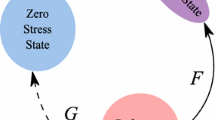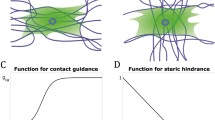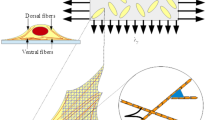Abstract
Due to the increasing importance of the extracellular matrix in many biological problems, in this paper we develop a model for fibroblast and collagen orientation with the ultimate objective of understanding how fibroblasts form and remodel the extracellular matrix, in particular its collagen component. The model uses integrodifferential equations to describe the interaction between the cells and fibers at a point in space with various orientations. The equations are studied both analytically and numerically to discover different types of solutions and their behavior. In particular we examine solutions where all the fibroblasts and collagen have discrete orientations, a localized continuum of orientations and a continuous distribution of orientations with several maxima. The effect of altering the parameters in the system is explored, including the angular diffusion coefficient for the fibroblasts, as well as the strength and range of the interaction between fibroblasts and collagen. We find the initial conditions and the range of influence between the collagen and the fibroblasts are the two factors which determine the behavior of the solutions. The implications of this for wound healing and cancer are discussed including the conclusion that the major factor in determining the degree of scarring is the initial deposition of collagen.
Similar content being viewed by others
References
Alberts, B., B. Dennis, J. Lewis, M. Raff, K. Roberts and J. D. Watson (1994). Cell junctions, cell adhesion, and the extracellular matrix, in Molecular Biology of the Cell. 3 edn, pp. 978–986, Garland Publishing.
Besseau, L. and M. M. Giraud-Guille (1995). Stabilization of fluid cholesteric phases of collagen to ordered gelated matrices. J. Mol. Bio. 251, 197–202.
Birk, D. E. and R. L. Trelstad (1986). Extracellular compartments in tendon morphogenesis: Collagen fibril, bundle, and macroaggregate formation. J. Cell Bio. 103, 231–240.
Bray, D. (1992). Cell Movements. Garland Publishing.
Brown, P. N. and Y. Saad (1987). Hybrid Krylov Methods for Nonlinear Systems of Equations. Technical Report, Lawrence Livermore National Laboratory.
Byrne, H. M. and M. A. J. Chaplain (1996). Modelling the role of cell-cell adhesion in the growth and development of a carcinoma. Math. Comp. Modelling 24, 1–17.
Civelekoglu, G. and L. Edelstein-Keshet (1994). Modelling the dynamics of F-actin in the cell. Bull. Math. Bio. 56, 587–616.
Clark, R. A. F. (Ed.) (1996a). The Molecular and Cellular Biology of Wound Repair, 2 edn, New York: Plenum Press.
Clark, R. A. F. (1996b). Wound repair overview and general considerations, in The Molecular and Cellular Biology of Wound Repair, (Ed.) R. A. F. Clark 2 edn, pp. 3–50, New York: Plenum Press.
Clark, R. A. F., L. D. Nielsen, M. P. Welch and J. M. McPherson (1995). Collagen matrices attenuate the collagen-synthetic response of cultured fibroblasts to TGF-β. J. Cell Sci. 108, 1251–1261.
Cook, J. (1995). Waves of alignment in populations of interacting, oriented individuals. Forma 10, 171–203.
Dale, P. D., J. A. Sherratt and P. K. Maini (1996). A mathematical model for collagen fibre formation during foetal and adult dermal wound healing. Proc. R. Soc. Lond. B263, 653–660.
Deutsch, A. (1995). Towards analysing complex swarming patterns in biological systems with the help of lattice-gas cellular automata. J. Biol. Systems 3, 947–956.
Edelstein-Keshet, L. and B. G. Ermentrout (1990). Models for contact-mediated pattern formation: cells that form parallel arrays. J. Math. Bio. 29, 33–58.
Elsdale, T. (1973). The generation and maintenance of parallel arrays in cultures of diploid fibroblasts, in Biology of Fibroblast, E. Kulonen and J. Pikkarainen (Eds), New York: Academic Press.
Geigant, E., K. Ladizhandsky and A. Mogilner (1998). An integro-differential model for orientational distributions of F-actin in cells. SIAM J. Appl. Math. to appear.
Grunbaum, D. (1994). Swarming behaviour as an aide to chemotaxis, in 3D Animal Aggregations, J. Parrish and W. Hammner (Eds), Cambridge: Cambridge University Press.
Grunbaum, D. (1998). Advection-diffusion equations for generalised tactic searching behaviors. J. Math. Bio. in press.
Guido, S. and R. T. Tranquillo (1993). A methodology for the systematic and quantitative study of cell contact guidance in oriented collagen gels. J. Cell Sci 105, 317–331.
Harmon, C. B., B. D. Zelickson, R. K. Roenigk, E. A. Wayner, B. Hoffstrom, M. R. Pittelkow and D. G. Brdoland (1995). Dermabrasive scar revision—immunochemical and ultrastructural evaluation. Dermatol. Surg. 21, 503–508.
Jiang, W. G. and R. E. Mansel (1996). Progress in anti-invasion and anti-metastasis research and treatment. Int. J. Oncology 9, 1013–1028.
Maini, P. K. (1990). Superposition of modes in a caricature of a model for morphogenesis. J. Math. Bio. 28, 307–315.
Mast, B. A. (1992). The skin, in Wound Healing Biochemical and Clinical Aspects, I. K. Cohen, R. F. Diegelmann and W. J. Lindblad (Eds), pp. 344–355, Philadelphia: Saunders.
McCallion, R. L. and M. W. J. Ferguson (1996). Fetal wound healing and the development of antiscarring therapies for adult wound healing, in The Molecular and Cellular Biology of Wound Repair, 2 edn, R. A. F. Clark (Ed.), pp. 561–600, New York: Plenum Press.
Mogilner, A. and L. Edelstein-Keshet (1995). Selecting a common direction. I. How orientational order can arise from simple contact responses between interacting cells J. Math. Bio. 33, 619–660.
Mogilner, A. and L. Edelstein-Keshet (1996). Spatio-angular order in populations of self-aligning objects: formation of oriented patches. Physica D 89, 346–367.
Mogilner, A., L. Edelstein-Keshet and B. G. Ermentrout (1996). Selecting a common direction. II. Peak-like solutions representing total alignment of cell clusters. J. Math. Bio. 34, 811–842.
Murray, J. D. (1993). Mathematical Biology, 2 edn, pp. 241–244, New York: Springer.
Neubert, M. G., M. Kot and M. A. Lewis (1995). Dispersal and pattern formation in a discrete-time predator-prey model. Theoret. Pop. Bio. 48, 7–43.
Okuba, A. (1986). Dynamical aspects of animal grouping: swarms, schools flocks, and herds. Adv. Biophys. 22, 1–94.
Olsen, L., J. A. Sherratt and P. K. Maini (1995). A mechanochemical model for adult dermal wound contraction and the permanence of the contracted tissue displacement profile. J. Theor. Bio. 177, 113–128.
Osher, S. and S. R. Chakravarthy (1984). High resolution schemes and the entropy condition. SIAM J. Numer. Anal. 21, 955–984.
Perumpanai, A. J., J. A. Sherratt, J. Norbury and H. M. Byrne (1996). Biological inferences from a mathematical model for malignant invasion. Invasion and Metastasis 16, 209–221.
Pollard, T. D. and J. A. Cooper (1986). Actin and actin-binding proteins. A critical evaluation of mechanisms and function. Ann. Rev. Biochem. 55, 987–1035.
Shah, M., D. M. Foreman and M. W. J. Ferguson (1992). Control of scarring in adult wounds by neutralising antibody to transforming growth factor β. Lancet 339, 213–214.
Shah, M., D. M. Foreman and M. W. J. Ferguson (1994). Neutralising antibody to TGF-β 1,2 reduces cutaneous scarring in adult rodents. J. Cell Sci. 107, 1137–1157.
Sherratt, J. A. and J. Lewis (1993). Stress-induced alignment of actin filaments and the mechanics of cytogel. Bull. Math. Bio. 55, 637–654.
Stevens, A. (1995). Trail following and aggregation of myxobacteria. J. Bio. Systems 3, 1059–1068.
Stopak, D. and A. K. Harris (1982). Connective tissue morphogenesis by fibroblast traction. Devel. Bio. 90, 383–398.
Sweby, P. (1984). High resolution schemes using flux limiters for hyperbolic conservation laws. SIAM J. Numer. Anal. 21, 995–1011.
Thurburn, J. (1996). Multidimensional flux-limited advection schemes. J. Comp. Phys. 123, 74–83.
Welch, M. P., G. F. Odland and R. A. F. Clark (1990). Temporal relationships of F-actin bundle formation, collagen and fibronectin matrix assembly, and fibronectin receptor expression to wound contraction. J. Cell Bio. 110, 133–145.
Author information
Authors and Affiliations
Rights and permissions
About this article
Cite this article
Dallon, J.C., Sherratt, J.A. A mathematical model for fibroblast and collagen orientation. Bull. Math. Biol. 60, 101–129 (1998). https://doi.org/10.1006/bulm.1997.0027
Received:
Accepted:
Issue Date:
DOI: https://doi.org/10.1006/bulm.1997.0027




